Introduction
Tetsuya Ishida, a visionary Japanese artist, captivates audiences with his surreal depictions of the human experience. His work, rich in symbolism and haunting beauty, offers a profound commentary on modern life’s pressures and alienation. Ishida’s paintings, characterized by their unique blend of humans and machines, reflect a society in transition, caught between tradition and the onslaught of technological advancement.
Born in 1973 in Yaizu, Japan, Ishida grew into his role as an artist during a time of significant societal change. His early life and education provided a backdrop to his intricate paintings, which often delve into themes of isolation, identity, and societal expectations. Despite his career being cut tragically short by his untimely death in 2005, Ishida’s body of work continues to resonate with audiences around the globe, drawing attention to the complexities of contemporary life.
Tetsuya Ishida’s Artistic Style
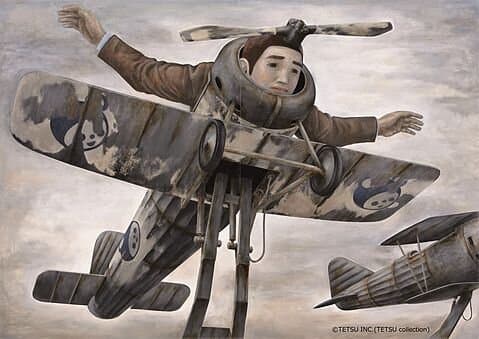
Ishida’s Unique Visual Language
Ishida’s paintings stand out for their detailed, surreal imagery. He masterfully blends elements of the human form with machinery and everyday objects, creating a disconcerting world where the boundaries between organic and artificial blur. This fusion serves as a powerful metaphor for the loss of identity and autonomy in the face of societal and technological forces.
Techniques and Mediums
Primarily using acrylics, Ishida developed a technique that allowed for a meticulous level of detail and a vivid palette. His method involved layering colors and textures to achieve depth and luminosity, bringing his complex, dream-like scenes to life with startling clarity.
The Theme of Alienation
A recurring theme in Ishida’s work is the sense of alienation felt by individuals in modern societies. He portrays this through characters placed in mundane yet surreal settings, such as a classroom or a train, where they merge with their surroundings, losing their identity.
Symbols and Recurring Imagery
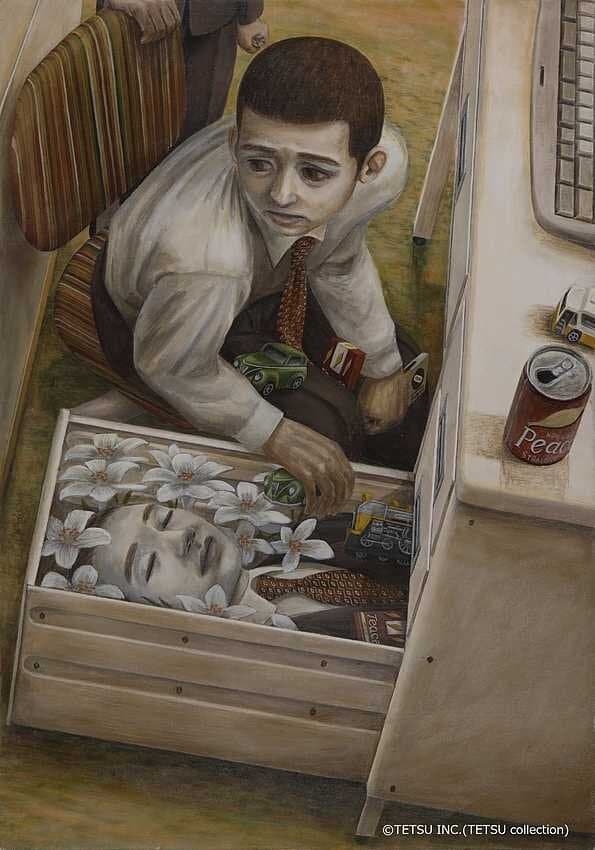
Ishida’s paintings are replete with symbols that evoke the struggles of contemporary life. Trains, often depicted as elongated, serpentine forms, represent the relentless march of time and progress, while classrooms and office spaces allude to the confining structures of societal expectations.
Influences on Tetsuya Ishida
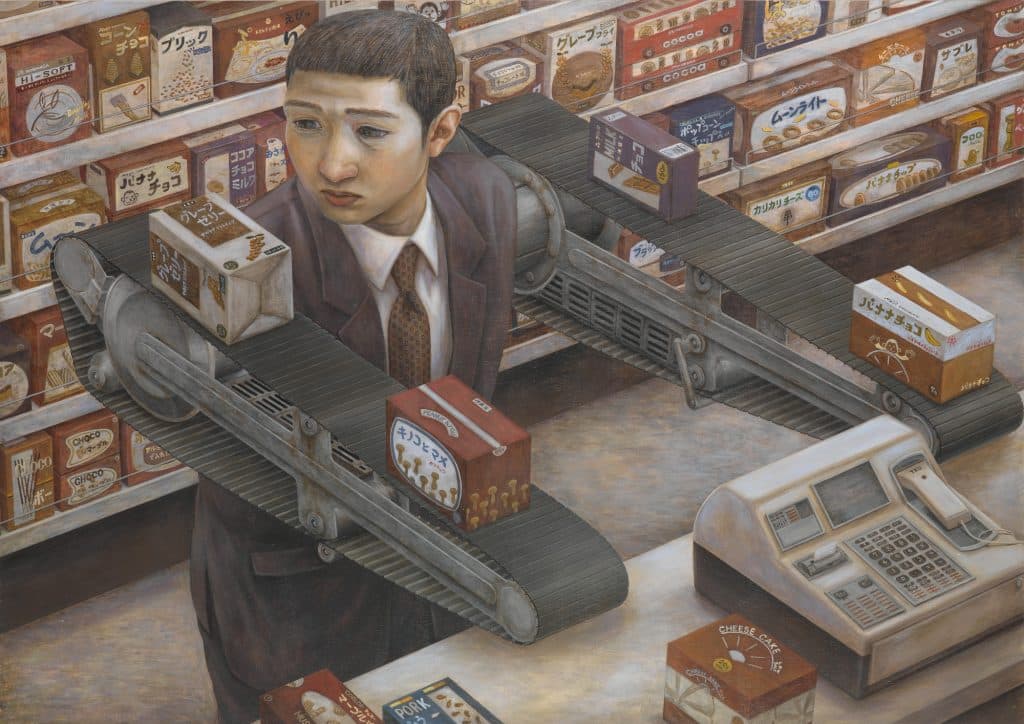
Cultural Influences
The rapid changes in Japanese society during the late 20th century, especially the lost decade of economic stagnation, deeply influenced Ishida. His work reflects the collective anxiety of a generation facing uncertain futures, critiquing both the breakdown of traditional values and the alienating effects of modernity.
Personal Experiences
Ishida’s paintings are deeply personal, drawing from his own feelings of disillusionment and isolation. His experiences as a young artist trying to find his place in a rapidly changing world are evident in his introspective and often somber portrayals of individual struggle.
Historical Context
Japan’s historical context, transitioning from the post-war era into the modern age, provides a backdrop for Ishida’s critique of societal and technological advancement. His work captures the tension between past and future, tradition and innovation, reflecting broader debates within Japanese culture.
Major Artworks of Tetsuya Ishida
Self-Portraits: Windows to the Soul
Ishida’s self-portraits are particularly revealing, offering a glimpse into the artist’s psyche. In these works, Ishida often depicts himself merging with elements of his environment, a visual representation of his internal conflict and search for identity.
Society and Isolation
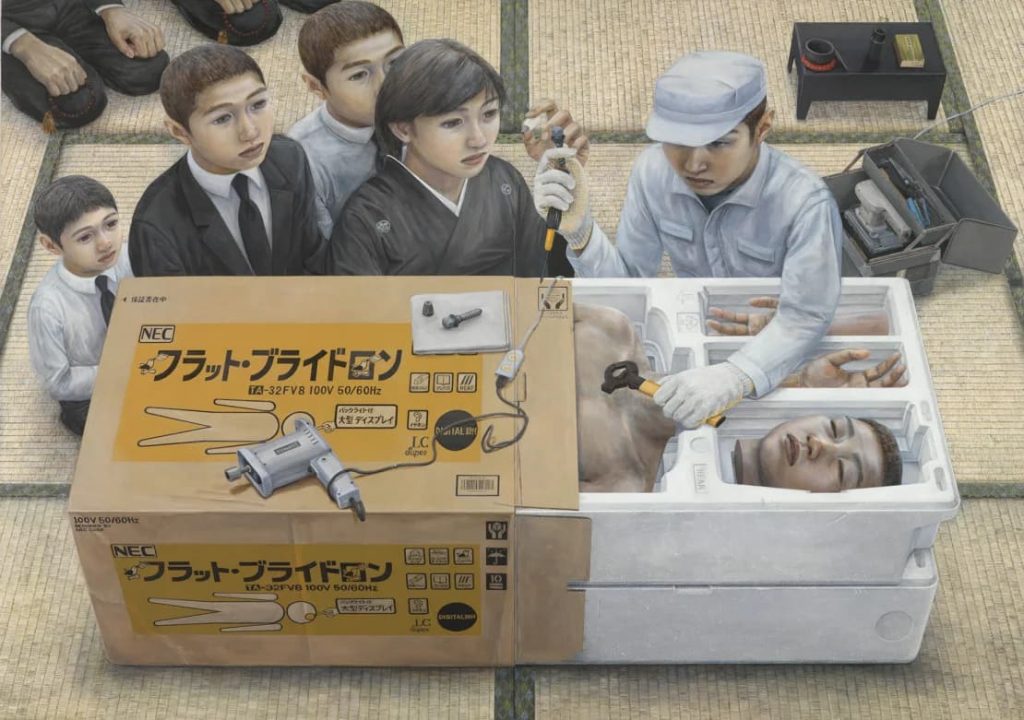
Paintings like “Recalled” depict individuals in scenarios where they are physically or metaphorically trapped, highlighting the dehumanizing effects of societal roles and expectations. These works prompt viewers to consider their own relationship with the social constructs that define modern life.
The Impact of Technology
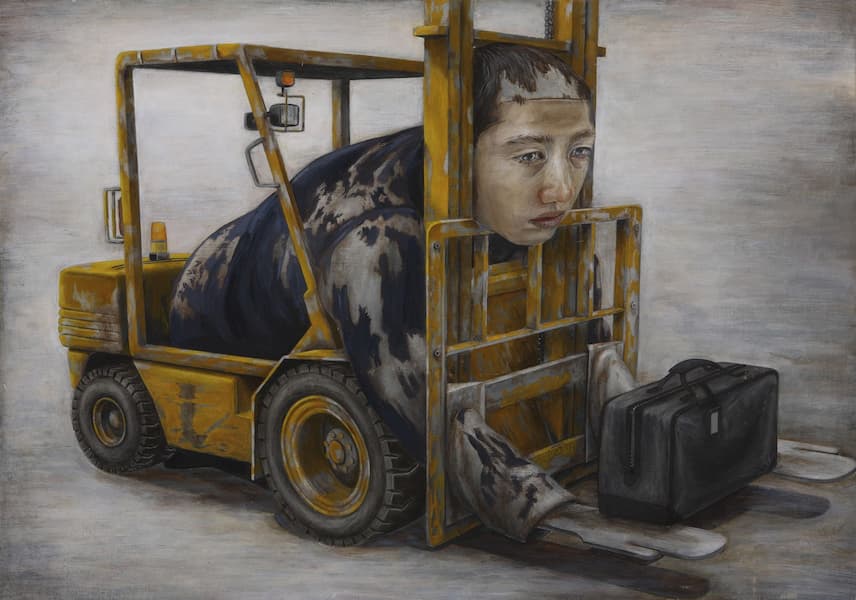
In works such as “Gripe,” Ishida explores the impact of technology on human life. His characters, often shown interfaced with or transformed by technological devices, serve as a cautionary tale about the potential for technology to dominate and dehumanize.
Tetsuya Ishida and Japanese Art
Ishida’s Place in Modern Japanese Art
Ishida’s work occupies a unique position in Japanese art, bridging the gap between traditional themes of nature and harmony and contemporary concerns of alienation and identity. His ability to articulate the existential angst of the modern individual places him among the most important Japanese artists of his generation.
Comparisons with Contemporary Artists
While distinct in his thematic focus and stylistic approach, Ishida can be compared to contemporaries such as Takashi Murakami and Yoshitomo Nara, who also explore the complexities of modern life through their art. However, Ishida’s work is distinguished by its more direct, somber engagement with the themes of alienation and identity.
Tetsuya Ishida’s Legacy
Ishida’s influence extends beyond the art world, touching on discussions about the human condition in the modern age. His work has inspired a new generation of artists and thinkers to explore the intersections of technology, society, and self. Ishida’s legacy is a testament to the power of art to provoke thought and inspire change, ensuring his place as a pivotal figure in both Japanese and global art history.
Understanding Ishida’s Themes

Ishida’s exploration of themes such as the struggle for identity, the critique of modern society, and the search for meaning amidst chaos, provides a roadmap for understanding the human experience in the contemporary world. His work encourages a reflective engagement with the forces that shape our lives, inviting viewers to consider their own place within the broader tapestry of society.
Drawing Insights from Ishida’s Exhibitions and Global Recognition
The recent exhibition of Tetsuya Ishida’s work at prestigious galleries, including the Gagosian, underscores the global recognition and relevance of his art. These exhibitions not only highlight the technical brilliance and emotional depth of Ishida’s paintings but also offer new perspectives on his critique of societal pressures and the alienation of the individual. The international acclaim for Ishida’s work demonstrates the universal appeal of his themes, reflecting shared human experiences across cultures and generations.
The Gagosian’s showcase of Ishida’s art, featuring key works from his oeuvre, provides a unique opportunity for audiences to engage with his profound messages. The exhibition, hailed as a significant event in the art world, attracts viewers from all walks of life, further cementing Ishida’s status as an influential figure in contemporary art. This global platform has played a crucial role in introducing Ishida’s vision to a wider audience, sparking conversations about the role of art in addressing complex societal issues.
Gagosian now represents Ishida globally.
Continuing the Conversation: Ishida’s Influence

The conversation around Ishida’s work continues to thrive, facilitated by online platforms and academic discussions. His art is increasingly used as a tool for education, helping students and young artists to navigate the complex landscape of modern identity and societal pressure.
Conclusion: Reflecting on Ishida’s Artistic Journey
Tetsuya Ishida’s artistic legacy is a profound exploration of the human condition in the face of the relentless advance of society and technology. His unique visual language and thematic focus speak to the heart of existential struggles, making his work not only a cornerstone of contemporary Japanese art but also a global symbol of the search for meaning in an increasingly complex world. Ishida’s paintings, marked by their surreal beauty and deep emotional resonance, continue to inspire and challenge viewers, ensuring his place as a timeless voice in the dialogue about humanity and its future.
As the world grapples with rapid changes and technological advancements, Ishida’s work remains a critical lens through which to examine the impact of these forces on the individual and society. His legacy, preserved through exhibitions and scholarly work, invites ongoing discussion and appreciation, underscoring the enduring relevance of his art. In reflecting on Ishida’s journey, we are reminded of the power of the creative spirit to illuminate the most pressing issues of our time, offering insights that transcend cultural and temporal boundaries.
Artwork by Tetsuya Ishida © Tetsuya Ishida Estate; photos: Martin Wong
Find out more at tetsuyaishida.net
Read more:
- Kamisaka Sekka: A Maestro of Ukiyo-e’s Evolving Canvas
- Yoshitomo Nara: Blending Ukiyo-e and Pop Culture in Japanese Art
- Tatsuro Kiuchi: The Japanese Illustrator Who Loves Old Things
- Yayoi Kusama: A Polka-Dotted Revolution in Art

At The Art of Zen we carry a selection of our own hand-crafted original Japanese art prints in the ukiyo-e and Japandi style. Some of our best selling work is Mount Fuji wall art and Japandi wall art.
Add some zen to your space with brilliant original art from the Art of Zen shop.




0 Comments